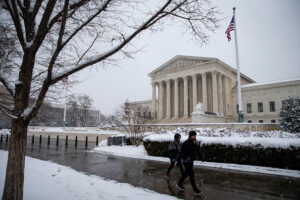
(Photo by Al Drago/Getty Images)
The rapid erosion of the Supreme Court’s legitimacy was on full display last week when district court decisions from opposite ends of the political spectrum looked the supposed highest court in the land squarely in the eye and told the august body to cram it. In an age of political gridlock, all sides can at least agree that the institution charged with holding the constitutional order together lacks credibility.
Yay?

The Trump Gold Card: A New $1 Million Pathway To A U.S. Green Card
A new proposal would let wealthy foreign nationals secure an opportunity for a U.S. green card with a $1 million 'gift' to the government, sparking legal and ethical debate.
Over the disturbingly nihilist dissent of three justices, the Court recently ruled that, no, a trial judge cannot tell the Defense Department how to achieve military readiness. A George W. Bush appointee in Texas had ruled that the Navy could not order SEALs to get the vaccine to continue serving in the unit. From the Navy’s perspective, the roughly 1.5 percent of SEALs resisting the vaccine jeopardized the readiness of their units, given that the success of these elite teams require teamwork and trust and individual members aren’t just fungible cogs to be replaced when they get put on a respirator for a preventable disease.
After years of preaching a theory of executive power that vests the presidency with godlike power, Justices Alito, Thomas, and Gorsuch joined the district court in second guessing what “commander-in-chief” really means. The other justices put aside differences to decide that whatever it means, it at least means people have to follow orders.
But faced with this clear rebuke from the Supreme Court, Judge Reed O’Connor doubled down. He expanded the case to a class action, struck down even more decisions of military leadership, and enjoined the government from taking action to separate these unvaccinated service members.
Apparently the Armed Forces aren’t the only institution with an insubordination problem.

Chrometa: Turning Time Into Billable Value For Modern Lawyers
Adoption of Chrometa represents more than a technological upgrade; it reflects a professional philosophy that values accuracy, transparency, and efficiency.
Meanwhile in Florida, Judge Mark Walker issued a 288-page ruling imposing a preclearance requirement on the state of Florida, blocking future changes to its election laws absent a court ruling on the proposal’s legality under the Voting Rights Act. Preclearance was once standard procedure for Florida, a jurisdiction on the bipartisan congressional preclearance list that the Supreme Court struck down in Shelby County. While that decision didn’t necessarily bar the door on a court reinstating preclearance requirements, no one thought to test the scope of the Court’s animosity toward this provision until now.
And Judge Walker didn’t try to hide the institution he was putting on blast:
In so ruling, this Court recognizes that the right to vote, and the VRA particularly, are under siege. See, e.g., Ark. State Conf. NAACP v. Ark. Bd. of Apportionment, No. 4:21-cv-01239-LPR, 2022 WL 496908, at *2 (E.D. Ark. Feb. 17, 2022) (dismissing a “strong merits case” that Arkansas had, to the detriment of Black voters, racially gerrymandered seats in the Arkansas House of Representatives under the theory that no private right of action is available under section 2 of the VRA); Merrill v. Milligan, 142 S. Ct. 879 (2022) (staying, without explanation, order enjoining racially gerrymandered congressional maps); Brnovich v. Democratic Nat’l Comm., 141 S. Ct. 2321, 2351 (2021) (Kagan, J., dissenting) (“Today, the Court undermines Section 2 [of the VRA] and the right it provides.”); Shelby Cnty., Ala. v. Holder, 570 U.S. 529 (2013) (gutting the VRA’s preclearance regime).
Never underestimate the amount of rhetorical heat a good writer can bring in a parenthetical.
Judge Walker’s response to Florida’s latest bevy of voter suppression tactics correctly applied the strictures of the Voting Rights Act as written, but like Judge O’Connor’s nonsensical reading of Article II, it’s a frontal assault on the idea of Supreme Court authority. This isn’t like striking down a dusty precedent of yesteryear — in both instances, these trial courts bucked recent Supreme Court holdings. In Judge O’Connor’s case, he spit on a SCOTUS opinion before the ink even dried.
But putting aside the merits of each judge’s decision, this is what a judicial crisis looks like. When trial judges hold the ultimate tribunal in the land with sufficient disdain to issue direct challenges like these, it’s hard to see how the system holds. Because the Supreme Court can’t take every case and, eventually, one of these lower court opinions will manage to stand because the justices can’t pencil it onto the docket.
This is the real cost of hijacking the Court for base politics. The cynicism of tanking Merrick Garland in contravention of the constitutional command to provide advice and consent — a phrase that at the very least means “have hearings and a vote” — only to follow it up with a beer-soaked meathead facing attempted rape allegations and mountains of mysterious debt and a slapdash rubber stamping of Amy COVID Barrett and her failure to clear the barest constitutional law hurdle managed to convince both sides of the proverbial aisle that the Court is little more than a life-tenured political proxy war. Throw in Alito and Thomas airing open contempt for established precedent and there’s little incentive to treat the rule of law as much more than vote-counting at this point.
Congratulations Chief Justice Roberts… this is your legacy!
Judge Blocks Military Vaccine Mandate Again, Dares Supreme Court to Stop Him [Slate]
Florida must seek court preapproval to change some voting laws, judge rules [The Guardian]
 Joe Patrice is a senior editor at Above the Law and co-host of Thinking Like A Lawyer. Feel free to email any tips, questions, or comments. Follow him on Twitter if you’re interested in law, politics, and a healthy dose of college sports news. Joe also serves as a Managing Director at RPN Executive Search.
Joe Patrice is a senior editor at Above the Law and co-host of Thinking Like A Lawyer. Feel free to email any tips, questions, or comments. Follow him on Twitter if you’re interested in law, politics, and a healthy dose of college sports news. Joe also serves as a Managing Director at RPN Executive Search.